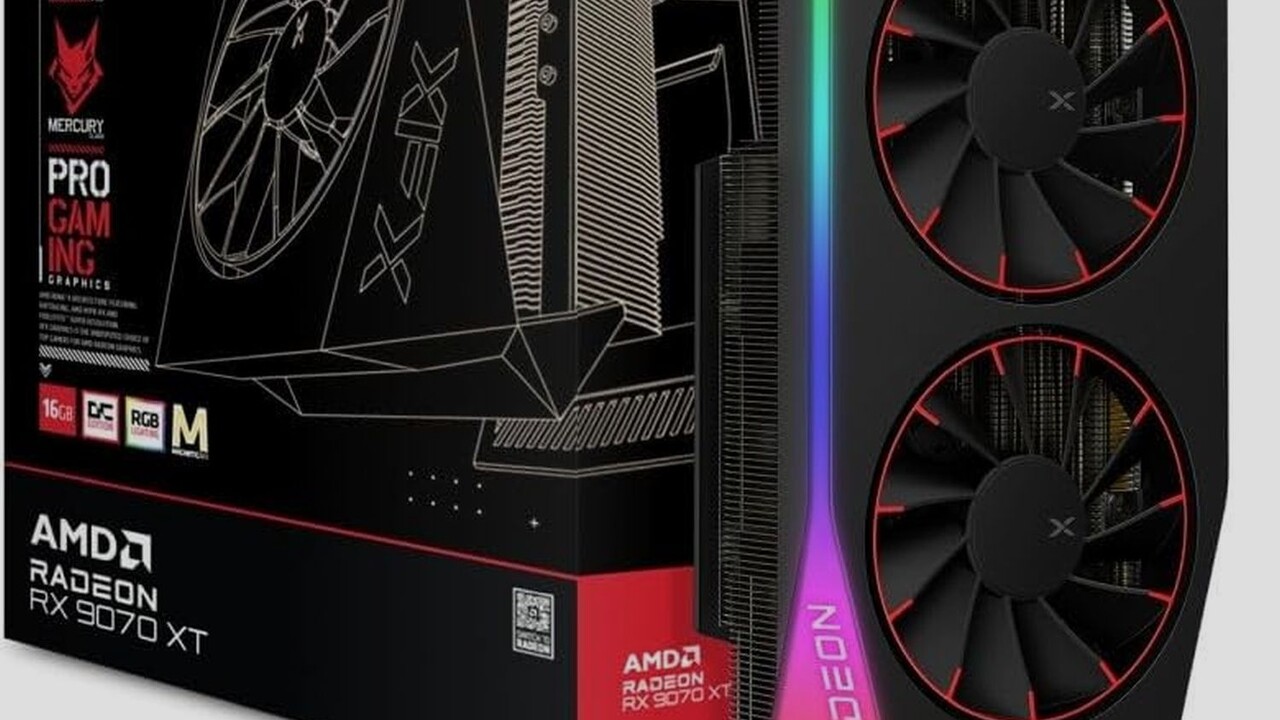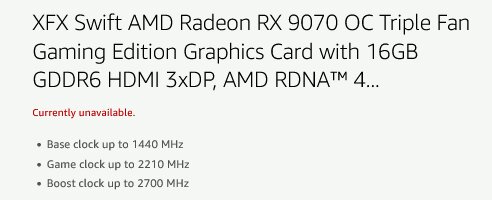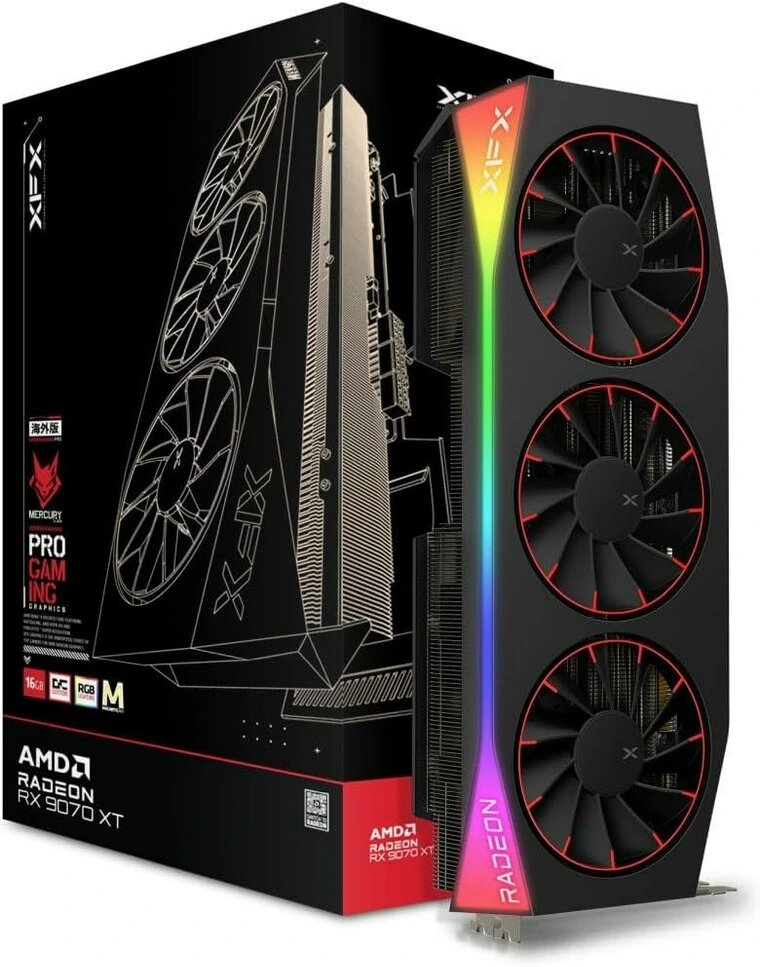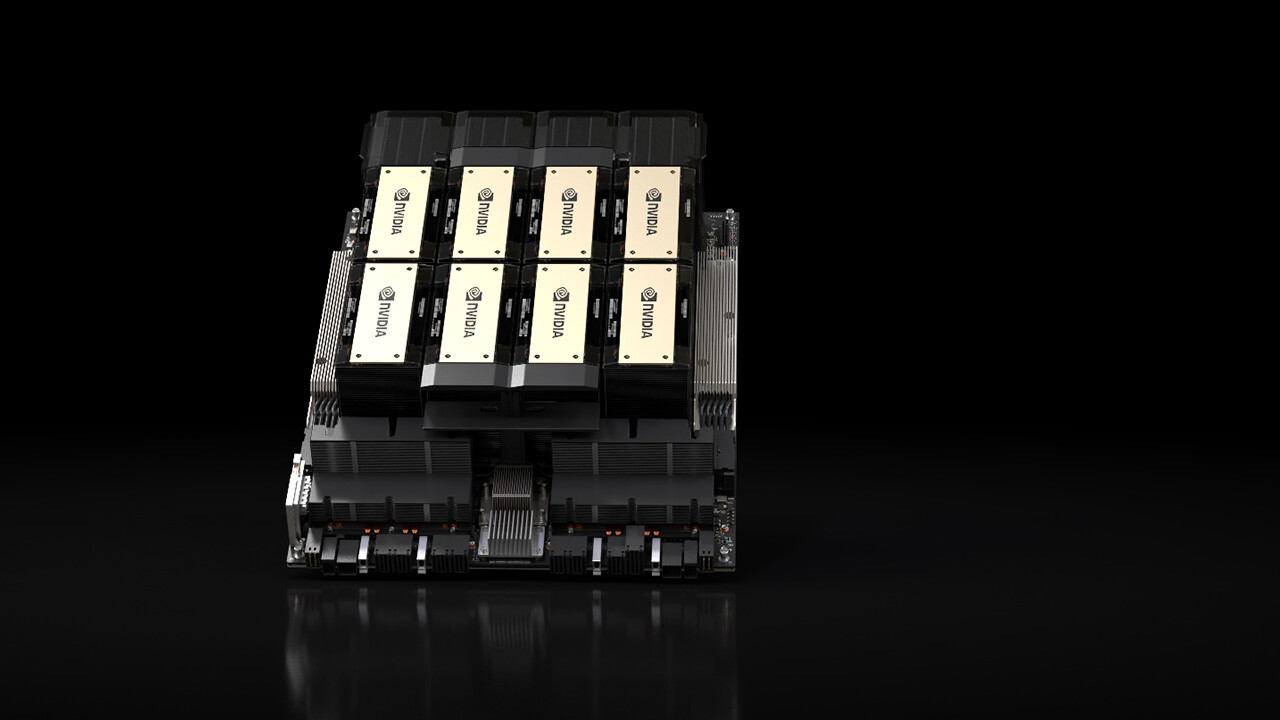Radeon RX 9070 (XT): Leaks provide photos of XFX, clock rates and final TDP 121 comments

Bild: I viamomomonda
In the meantime, offer pages for the upcoming Radeon RX 9070 and Radeon RX 9070 XT have already gone live on Amazon. On the one hand, models were revealed by BoardPartner XFX with images. On the other hand, clock rates have been called out.
Again the clock rates for the RX 9070 XT…
As already indicated by the revealed PowerColor portfolio, the Radeon RX 9070 XT will run with a gaming clock of 2,400 MHz and a boost clock of 2,970 MHz. At least that’s what the screenshots of the store pages were taken offline. For the first time, information is provided to the base cycle, which should be at 1660 MHz.
Overclocked models should “step up” to XFX with up to 3,100 MHz. This value was also obvious in advance.
…and for the RX 9070
With the Radeon RX 9070, which has so far had significantly fewer hints, there is now a base clock of 1,440 MHz, a gaming clock of 2,210 MHz, and a boost clock of 2,700 MHz. These values come from a screenshot, which however shows key data from an XFX SWIFT RX 9070 OC.
 XFX SWIFT RX 9070 OC with clock rates (Image: Imgur (via momomo_us))
XFX SWIFT RX 9070 OC with clock rates (Image: Imgur (via momomo_us))
With the PowerColor RX 9070 without overclocking, a gaming clock of 2,070 MHz and a slip clock of 2,520 MHz were mentioned. So this is probably like a baseline requirement.
AMD Radeon RX 9000 – Specifications (not officially) RX 9070 XX RX 9070 Architecture RDNA 4 GPU NAVI 48 Manufacturing TSMC N4 Transistors? Chip size ~ 390 mm² Cu 64 56 FP32-ALUS 4.096 / 8.192 3.584 / 7.168 RT CORES 64, 3rd generation 56, 3rd generation Base clock 1660 MHz? Game clock 2,400 MHz 2,070 MHz Boost clock 2,970 MHz 2,520 MHz FP32 Performance? FP16 Performance Texture Units 256 224 ROPS? L2 cache? L3 -cache 64 MB Memory 16 GB GDDR6 16 GB GDDR6 -PROAS 20 Gbps -Interface 256 Bit Bandwidth 640 GB/s AMD Radiance Video Engine (2nd generation) PCIe slot connection 5.0 × 16 TDP ~ 260 watts?
The XFX RX 9070 (XT) in pictures
The secured photos show the alleged XFX starting offer, which therefore consists of the RX 9070 Swift, RX 9070 Quicksilver and RX 9070 XT from the Swift, Quicksilver and Mercury series. An RX 9070 XT with “Magnetic Air” technology can also be expected based on the illustrations. This can be recognized by the red edge of the magnetically attached fan, which can be easily expanded.

XFX Mercury RX 9070 XT Air Magnetic (Image: Imgur (via momomo_us)) Image 1 of 16
End of February, testing / market launch in early March
It doesn’t take too long to finally provide detailed information from the official side. On February 28, a presentation begins at 2 p.m., which everyone can follow live on the AMD Gaming YouTube channel and in which the “RX 9000 series” is to be revealed.
The information is not as official as the first tests could be released on March 5. The market launch is scheduled to take place a day later on March 6.
Updated 02/21/2025 11:15 AM
In the meantime, the rumor mill also wants to be able to confirm the total card power (TBP, common TDP) of the two new graphics cards in their benchmark modifications: 304 watts for the Radeon RX 9070 watts for the for the Radeon RX 9070 and and and considerably lower than 220 watts for the for the Radeon RX 9070.
The large XT would be just below the Radeon RX 7900
Technical specifications of the AMD Radeon RX 7000 RX 7900 XTX RX 7900 XT 7800 XT RX RX 7700
1 × GCD + 6 × Chiplet MCD
1 × GCD + 5 × Chiplet MCD
1 × GCD + 4 × Chiplet MCD
1 × GCD + 3 × MCD TSMC N5 Monolithic Production (GCD)
TSMC N6 (MCD) TSMC N6 Transistors 57.7 billion 28.1 billion 13.3 billion 300 mm size chips (GCD)
37.5mm (1 × MCD) 200mm (GCD)
37.5 mm (1 x mcd) 204 mm² Cu / Sm 96 84 60 54 32 FP32-ALUS 6.144 / 12.288 5.376 / 10.752 3.840 / 7.680 3.456 / 6.912 2.048 / 4.096 RT-KERNE 96, 2nd Gen 84, 2nd Gen 60, 2nd Gen 54, 2nd Gen 32, 2nd Gen Ki-Inter 192, 1st Gen 168, 1st Gen 120, 1st Gen 108, 1st Gen 64, 1st gan gam gam gam gam gam gam gam gam gam gam gam gan gan-takt 2.300 MHz 2.000 MHz 2.124 MHz 2.171 MHz 2.470 MHz 2.250 MHz Boost-Takt 2.500 MHz 2.400 MHz 2.430 MHz 2.544 MHz 2.760 MHz 2.625 MHz Fp32-Ethenleisttug 61.4 Tflops 51.6 Tflops 37.3 Tflops 35.2 Tflops 45.2 Tflops 43 Tflops Textureinheiten 384 336 240 216 128 ROPS 192 96 64 L2-cache 6,144 KB 4,096 KB 2,048 KB Speicher 24 GB GDDR6 20 GB GDDR6 16 GB GDDR6 12 GB GDDR6 16 GB GBS SpeicheRinterface 384 Bit 320 Bit 320 Bit 320 Bit 256 Bit 192 Bit 128 Bit SpeicherBandBreite 960 GB/s 880 GB/s 624 GB/s 432 GB/s 288 GB/s Infinity-che 96 MB, 2nd Gen 80 MB, 2nd Gen 64 MB, 2nd Gen 48 MB, 2nd Gen 32 MB, 2nd Gen IC-PandBreite 2.5 TB/s 2.0 TB/s 2.1 TB/s 1.6 TB/s 200 GB/s slot-annbindung pcie 4.0 x 16 pCie 4.0 x 8 tbp 355 wat 315 watt 263 wat 245 Watt 190 Watt 165 Watt Thememen: AMD Grafikkarten Radeon RDNA 4 RX 9070 RX 9070 XT Quelle: X (Twitter)

An engineer by training, Alexandre shares his knowledge on GPU performance for gaming and creation.


